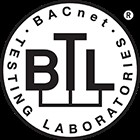am 29.05.2023 - 11:54 Uhr
"None of the smart buildings in Germany that have been realized at great expense in the last 10 years work as planned, tendered and paid for". This is the sobering experience of Patrick Lützel, Head of System Engineering Building Automation at TÜV SÜD and thus responsible for TÜV Süd's "Technical Monitoring" service offering. We will not achieve the climate targets set by the UN, the EU and Germany by 2045. Because without sustainable buildings, it won't work.
However, the benefits of digitalization and standardization only come into play if economies of scale are exploited and media disruptions in the process are avoided. The fact that the same components are implemented uniformly with BACnet means that users no longer have to plan twice, and engineering and, in particular, operating the systems becomes easier. In simplified terms, one could speak of "series production"; not every pump is implemented differently.
If an organization operates several properties, if a planner creates several plans or if an integrator implements several building automation systems, the interoperable communication protocol "Building Automation and Control Networks" (BACnet) is indispensable. BACnet has existed as a communication standard for 25 years and has achieved a high level of market penetration and maturity worldwide (Revision 21). BACtwin is intended to exploit the advantages of digitalization for planning, engineering and operation, whereby the organizational part of ISO 16484 Part 3 is still available in the first version from almost 20 years ago.
A mammoth task for politics and business
Here are some figures to illustrate the topic: Despite many measures to save energy, energy consumption in Austria has remained constant since 2005. The Austrian government program now stipulates that the 98.5 TWh used annually as heating energy must come from CO2-neutral energy sources by 2040. This represents a mammoth task for politics and business, which can only be implemented economically through digitalization.
By digitizing building automation, considerable savings can be achieved with much less investment than by insulating the building, replacing the windows or similar measures. These immediate savings can then be used for additional insulation. Digitalization also makes user behaviour transparent - and this enables the most efficient and effective measures in the heating transition to be developed. Interoperable digitalization also means that the necessary information is available at the right time. The building of the future must also meet the user's needs. Users will only feel comfortable in the building and act in an energy-efficient manner if the current demand can be controlled in concrete terms using information from the BACtwin.
Implementing an interoperable solution
The Austrian Armed Forces accepted this challenge almost a decade ago and developed an interoperable solution in an open process with the industry. In order to largely eliminate media discontinuities between client specifications, planning output, engineering and operation, the Austrian Armed Forces developed the BACtwin concept, which has been implemented in the properties for more than five years. In addition, a testing tool, an implementation guide and a GA library for the BACtwin were created.
An "upgraded" BACtwin will be published in Germany in the summer of 2023 via an AMEV (Arbeitsgemeinschaft öffentlicher Auftraggeber) set of rules for public buildings. The BACtwin will then be incorporated into the standard performance book for the construction industry. As
some parts of the GA industry do not yet know how they want to deal with BACtwin, it will still take a while before the gap in the GA world standards is closed.
Furthermore, the Austrian Armed Forces have standardized elements of the building automation system such as units (motors, fans) and systems so that they can be implemented digitally throughout the entire building life cycle - from planning to implementation and operation - without media discontinuity. The use of the uniform building automation library injected by the Austrian Armed Forces supports the implementation of the Green Deal and the circular economy in terms of efficiency and effectiveness for the properties of the Austrian Armed Forces.
Graphic: Optimization of building technology
When do I need Technical Monitoring?
Ideally, technical monitoring should be implemented before acceptance of the building automation system so that defects can be rectified during construction before acceptance. However, technical monitoring is also necessary during the warranty and operating phases in order to ensure efficient management of the building.
Conclusion:
Without efficient building management, decarbonization will not succeed. All buildings are not functioning properly and are inefficient, even those constructed according to modern standards in the last ten years. Technical monitoring reveals errors and provides the basis for efficient operation. Ideally, technical monitoring should be part of the commissioning process, allowing for quick error resolution with all stakeholders involved. At the latest, during operation, technical monitoring is necessary to correct misconfigurations and operate buildings efficiently. A manufacturer-neutral Building Engineering (MBE) with open interfaces significantly reduces the effort required for technical monitoring.
Cool down - Are buildings actually as sustainable as promised by the developer? The free TÜV SÜD Green Building Calculator compares buildings with sustainability goals: When will the building exceed the decarbonization path of the Carbon Risk Real Estate Monitor (CRREM) and become a stranded asset? What energy costs can be expected in the future? What measures are possible? www.tuvsud.com/en/landing/global/greenbuildingcalculator

The ICONAG MBE (Management and Operating Device) software has been certified as a B-AWS (Bacnet Advanced Workstation) according to the current BACnet Revision 19.
Powered by ModuleStudio 1.3.2